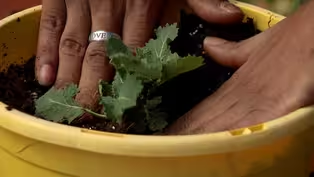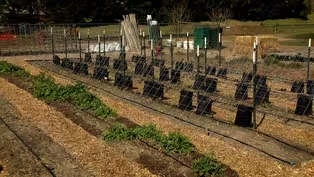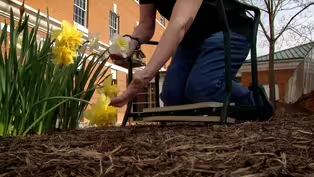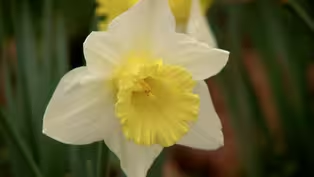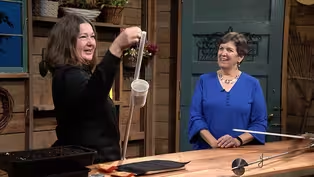Virginia Home Grown
Clippings: Senior Gardening
Clip: Season 23 Episode 1 | 26m 46sVideo has Closed Captions
Discover the benefits of gardening for seniors in retirement communities!
Peggy Singlemann meets Marta Hill Gray at Culpepper Garden, where 30,000 daffodils decorate the landscape for residents to tend and enjoy. Serome Hamlin visits Jen Alexander at Covenant Woods Senior Living where residents grow their own vegetables. Randy Battle and Dr. Robyn Puffenbarger share garden tips. Engage with us or watch full episodes at vpm.org/vhg.
Problems playing video? | Closed Captioning Feedback
Problems playing video? | Closed Captioning Feedback
Virginia Home Grown is a local public television program presented by VPM
Virginia Home Grown
Clippings: Senior Gardening
Clip: Season 23 Episode 1 | 26m 46sVideo has Closed Captions
Peggy Singlemann meets Marta Hill Gray at Culpepper Garden, where 30,000 daffodils decorate the landscape for residents to tend and enjoy. Serome Hamlin visits Jen Alexander at Covenant Woods Senior Living where residents grow their own vegetables. Randy Battle and Dr. Robyn Puffenbarger share garden tips. Engage with us or watch full episodes at vpm.org/vhg.
Problems playing video? | Closed Captioning Feedback
How to Watch Virginia Home Grown
Virginia Home Grown is available to stream on pbs.org and the free PBS App, available on iPhone, Apple TV, Android TV, Android smartphones, Amazon Fire TV, Amazon Fire Tablet, Roku, Samsung Smart TV, and Vizio.
Providing Support for PBS.org
Learn Moreabout PBS online sponsorship>>One of our residents, she was able to do some fundraising.
We were able to buy two shelves with seedling lights and we took the old shed where we used to get screened for COVID, and we turned that into our seedling shed now.
>>Wow, that's very nice to have a new life on something that's a little dark.
>>Yeah, so in there, we'll probably do about 9,000 plants.
>>These daffodils are a byproduct of our namesake, Dr. Charles Culpepper, he sold them to the neighbors over time.
People have come to us to say, "Oh, when I was child, he'd have a wheelbarrow with bundles of daffodils for 25 cents or 50 cents."
So, we love the spirit of the daffodils and we are continuing on today.
>>Production funding for "Virginia Home Grown" is made possible by.
(birds chirping) (upbeat music) Welcome to Virginia Home Grown.
Today we are highlighting the role that gardens play in senior living communities and the benefits they bring to residents.
Serome Hamlin visited Covenant Woods Senior Living to learn about their farm to table program, where residents volunteer to grow vegetables that are used in the on-campus restaurants.
He met with farm manager Jen Alexander to tour the garden and learn about her collaborative work with the chef, as a new growing season was about to begin.
>>I am a really good weeder.
I know it's hard, but a lot of people can't go down on their knees and crawl around.
That's the best part.
If you crawl around in this soil, it's all worms.
It's just beautiful, beautiful worms.
I come here because it is just so relaxing and I find a lot of peace here.
>>My favorite volunteer duty for this garden is harvesting some of the produce, just because I know it's going into the kitchen and we feel like we're eating so much better and it's very much more flavorful than what we can buy at the store.
>>I started volunteering in the garden when everything got closed down because of COVID, and I figured I could this is something I could do, I'd be outside.
We still, you know, if we were in close contact, had a mask it's good exercise and it's out in the fresh air and so I just took that on as the thing I was gonna do.
>>Right now we're walking through the resident portion of the garden.
They can grow food in their own plot.
Some of them were farmers and so this is a nice transition for them to grow their own food still.
Lots of them like to take their own food back to their cottage or to their apartment and cook for themselves or you know it's a pretty good walk back to the main building.
So along the way there's plenty of neighbors to share with.
>>Oh yeah it definitely looks like a nice productive garden area >>Along this edge I like to grow herbs, some trap crops like amaranth I'll put some sunflowers here as well as some native plants and pollinators and that really helps balance the whole ecosystem and just makes everything grow a lot better over in the garden.
>>Nice, so let's take a visit to the production garden.
>>Right now we've got some cabbage and that overwintered, we had some things that did not overwinter like that one really bad night that we had, that pretty much did the chard in, but I was able to keep some arugula, some spinach, the collards we just took in.
We've also got some lettuce going now.
I have to keep an eye on that.
If it gets 28 or below I'm gonna get some buckets on top of that and protect it.
>>I know, we are having a weird, weird season, so >>Right, it's a lot of back and forth but if I put the netting on that's gonna knock off a little bit of the frost and then there's nothing out here that isn't good with the cold and then I've got blankets staged on each row.
That way those can go on quickly.
>>So you have your residents and they have their own gardens and I know how this is split up into two different sections.
So does the residents kind of help you out as far as volunteers?
>>Yes, and I couldn't ask for anything better really than to have that kind of help and assistance.
They take a lot of pride in both their individual garden and helping with something that helps the whole community.
>>What opportunities do they have helping in the production garden?
>>They can help with harvesting, they can help with seeding trays and just generally anything that we do in the garden.
And they can choose their own schedule.
Some of them prefer to do like a day of the week and they will come every week and then others are on the periphery and they will, you know, have a looser schedule.
And then even some people do things like make art for the garden.
We have a woman who makes false wasps nest.
She crochets them and knits them and we hang them in the shed or the greenhouse to kind of deter wasps in there.
We have other residents that will bring their compost to the compost pile and there's a wood shop here.
And so residents in the wood shop have made bluebird feeders.
They've made the seedling frame for the netting to protect seedlings where we harden them off.
I depend on everybody very much and it really shows with what we're able to produce here.
>>What is the production rates for the kitchen >>As is in poundage?
>>Yes.
>>Like the first year we only had 4,000 square feet and we were still getting started and still gathering supplies.
So the first year we did about 2200 pounds.
Right now we've gotten 4,500 pounds and I go by their fiscal year, so I'll go April to March.
So we're almost done with the year and we're about at 4,500 pounds.
>>Wow, so it is a nice productive garden.
>>Yes.
>>It's simple fresh food and that's what our focus has always been how that farm ties into the kitchen program.
It just brings the fresh to the highest level.
Being a formerly trained chef, I've always wanted to for probably the past 25 years, start an actual farm to table program utilizing the land that's on the campus.
It all really started for two purposes.
One was to obviously give the chefs the greatest and freshest food to work with.
The other part is the relationships that the farm built with the residents and some staff members allowing them to be outdoors and work with Jen, I think it keeps them young keeps them vibrant and it's wonderful for both the staff and the residents and the community.
Typically Jen and the chef will get together.
They'll talk about how much is going to be produced.
Jen is excellent about weighing the product so she'll know and let us know how many pounds are coming in.
We try to utilize those product in different aspects.
So in the past we've made tomato sauce.
We've made tomato pie, which is extremely popular.
We've even made Bloody Mary mix for the residents to utilize the product.
So yeah, it's pretty strategic in that way.
Knowing the amount that comes in and how much we need to use.
>>Starting in January, I'll meet up with the chef and we'll talk about what he wants for his dishes for the upcoming spring season.
And then we'll pretty much go back and forth about what can be successful out here.
Because sometimes mother Nature makes the decisions for us so really we can, we can really come up with something good.
>>So how do you keep everything organized?
>>When I meet with the chef, I'll bring a list myself and then he'll have in mind what he wants and we'll just go row by row and talk about it and really talk about what varieties he would like, take for instance, tomatoes, like he wants a slicer tomato.
And then I also know that like I will choose a bush tomato as opposed to a vine tomato just so that it is easier for me to harvest.
>>A lot better to maintain.
>>Yes, a lot easier to maintain.
>>And what other kinds of veggies do you get to have for the kitchen >>A lot of the times we'll do gold beets, red beets we'll do different kinds of kale.
They always have a really good curly kale salad or a beet salad.
The residents love green beans and potatoes >>And knowing that you're having to produce crops for the residents here.
So how do you manage pest?
>>We do integrated pest management.
We like to garden with wildlife out here.
So you know, a lot of our employees are parasitic wasps.
We grow a lot of mountain mint.
Like I've never had to spray the tomatoes because the mountain mint is down this center aisle and that pretty much takes care of all the tomato horn worms.
>>Well, it's nice to have mother nature on your side when it comes to pest management >>Right, right.
If she's gonna get us with the weather, then you know, she can give us some insects to do some work.
>>Thank you for giving me a tour of this garden.
What a great opportunity for people to come out and not only produce their own food where they know where it's coming from but to get outside and be active.
>>Yes, it's a great opportunity for them to get outside and I appreciate what they do and I'm so glad you were here today.
>>When people come to visit me, I always bring them to the garden because I'm so proud of it.
We've really got it well organized and Jennifer has done a great job of making sure that the plants get what they need.
It's just a really it's a wonderful thing for this institution.
The residents there are getting so many benefits from the fresh air and exercise to the delicious meals prepared with their own fresh ingredients.
They really do have a program to be proud of.
Some days, though, our minds are stronger than our bodies.
And horticulturalist Dr. Robyn Puffenbarger shares tips on how to keep gardening when knee hip or backaches challenge our desire to spend time in the garden.
(playful music) >>Gardening is for everyone, and we wanna try to take care of our knees, hips, and back as much as we can so we garden for longer and feel healthy and safe in the garden.
Today I wanted to show some tips on how to get off the ground so you don't stress your knees and back while you're getting ready to garden this spring.
So one of the things I like to do is to come here to the greenhouse at Bridgewater College and use this elevated table that puts me at exactly the right height.
So I have no stress I'm just putting the seeds right on the soil.
And this is just so easy.
No bending, no lifting and just watering in the little seeds.
If you don't have such a nice high table.
Conveniently in your house or in your garage you could always think about maybe a cheap card table or a folding table that you could take outside and either use in the garage if it's windy or wet or in the garden on a beautiful sunny day.
There are a number of other things you can purchase at your garden center or online if the height you need may be different because you're in a wheelchair.
I have another instrument that I really like for me and my garden.
I love a kneeler.
It has a pad, so I put my knees on this instead of the cold wet ground.
It's a little bit elevated and it has these wonderful handles so I can push up and lower myself very comfortably and carefully.
This has really come in handy for getting up and down in the garden.
The other thing that's a really great trick is this one flips so you have a wonderful little stool so you can sit in the garden and prune, pick and do whatever you need to do without being on your knees.
So make sure you take care of yourself in the garden.
Your knees, hips, and back, you want them to last as long as possible.
And when it comes time and you can't get down on the ground think about containers on your patio or deck and raised beds as another opportunity to stay in the garden getting your fingers in the soil and enjoying your plants.
Taking care of your knees and back is very important while spending time in the garden or through daily living.
Everyone can benefit from being aware of their movements and all they do, and gardening off the ground is a perfect first step.
And now let's visit Culpepper Garden, a senior community set on a landscape that features over 30,000 daffodils, some blooming annually for decades, to learn about the history of the property and the garden the residents enjoy year round.
>>They are so wonderful.
We get people come and take pictures.
But for the residents is an outlet, it's a pleasure, and for me, it's always a pleasure to be a gardener.
This is such a reasonable place to live.
When I moved here, I thought, "My goodness, I have to give back."
I just feel like that volunteerism is important.
>>I've been here four months, I guess, you know, I'm a newbie.
Everyone who really is successful living here, which means living for a long time, has a project.
That's the key to being old, is having a project that you really care about, and it consumes you.
So my project is gonna be helping the management make the best of this place.
>>Charles Culpepper, our namesake was a botanist, and he loved to create hybrid daffodils, and he created many, many, many that are planted here today.
So here we are 70, 80 years later, and we have his daffodils.
>>So how many did he create?
>>We don't know.
But we've identified 18 in our wooded areas and throughout the property, different types, so- >>I bet you they're beautiful.
>>Oh my gosh, they're magnificent.
And we have cream with orange trumpets and yellow and all different colors.
So I think a lot of people think of a daffodil as just a yellow flower, right?
But this is a far different thing, what this gentleman had created.
>>Well, that's exciting.
And so how many acres of property did he have?
>>We are on almost five acres, just under five acres.
So he sold it at a steep discount.
>>Right.
>>To the organization that started Culpepper garden, which was the Unitarian church, and he was a member there.
>>Right.
>>So he did this is an act of good faith.
And his legacy continues.
So we have low income senior housing here, and we have assisted living and independent living.
And many of our residents have very little so we provide a beautiful environment for them.
And it's sort of a diamond here in Arlington, Virginia.
>>Obviously, you've kept planting daffodils because we're walking through this lovely corridor of daffodils.
And I'm quite amazed at all the different colors and varieties you have here.
Particularly the way you've staggered the bloom season, you've got some that are in full bloom, others that are starting and others that are just coming out of the ground.
>>So every fall, we have volunteers come and we plant about 5000 daffodils, and then we see what happens then and then the next year we'll plant more so it's an annual event, we have a daffodil society that we raise funds to sell some daffodil bulbs.
So it's really a fun project.
>>That sounds like a fun project.
But I also love how you have taken these daffodils and you've underplanted or put them amongst many, what I see are native plants here and some other perennials so that it's not just daffodils and then it's a garden that's bare and mulch.
>>Right.
>>Ugh.
It's daffodils, but it's got the rest of the season covered as well.
>>Well, that's right.
And so we love that, we can't wait for the next plantings to grow and see what's coming up color, flowers to bring the butterflies in and the bees and all the wonderful things that some of the natives can bring us.
>>But what are you moving forward with in the future with these daffodils?
>>Well, we're going to be doing more planting in the fall.
And we're going to be identifying this year some of the flowers that we have and see what else we can find to sort of create more of a mix.
We're also gonna look at some of the flowers that we have in other parts of the garden from Dr. Culpepper to see if we can replicate those.
>>Oh, that would be great.
So you can sort of bring it some of the older cultivars back in.
>>Exactly, exactly.
It's a lovely story and our residents to this day here at Culpepper garden really enjoy the flowers and the garden all year round.
>>Oh, that's fantastic.
And to be surrounded by a garden to look out a window in your apartment down to this beautiful space, it just must bring them joy.
>>It does, and when COVID, when they were all locked down, we planted the daffodils.
And in that spring of 2021, it was spectacular and that brought a lot of joy.
And there were a lot of happy residents.
>>Oh, I couldn't think of a better way to do things.
(laughs) >>Yes, yes, it's great.
It's really great.
And they get engaged.
They want to know what we're planting while we're out here.
They stop by, what are you planting?
We have a gentleman here, he's a naturalist.
So he wants to make sure we don't have invasive species and he's a resident here.
He's 81 years old.
>>Well, this is a site that has both characteristics of a garden and characteristics of a remnant forest.
I would argue all the native plants deserve to live.
Most of the introduced plants are legacies and they deserve to live too.
I'm not into pulling out plants.
(chuckles) I love plants, but we want to get rid of the invasive plants particularly.
>>I'm sure it must be difficult for you like everybody else to just leave that daffodil foliage alone as it yellows.
>>Yes.
And you gave me a little tip today because sometimes people will go on to come down and tie the- >>Oh!
>>Right, right, (Peggy laughing) tie everything in knots.
And so when it's drooping, and we're in between seasons, I don't have Azaleas blooming, I don't have everything quite where I want it.
And I think, "Oh, my garden looks so sad."
But to have it look like this in spring, it's the price we pay, is that right?
>>Exactly.
(Martha chuckling) That's the way I feel about it.
Just remember the glory.
>>Yeah, yeah, that's right.
(Peggy laughing) >>Just remember being dazzled by the daffodils.
>>Dazzled by the daffodils.
Thank you, Peggy.
(Peggy laughing) >>But as we're walking down this walkway, we've gone from a full sun area and we're moving into a shade area and a partial shade area under these beautiful American Hollies.
And yet the daffodils are still blooming, and that's something else.
So I applaud you for choosing cultivars that can handle the shade as well.
>>We got some good advice.
So we've had some people come and give us some guidance, and we're looking for more guidance, because we really want to respect all these beautiful daffodils and plant them in the right place so we get the best result.
It's a lot.
>>Yes.
>>It's a lot to manage.
But it's pretty spectacular.
>>It is.
And people don't understand too the importance of fertilizing daffodils, they think in a few years, they have to dig them up and divide them.
And that is one way of managing this collection here.
But on the other hand, if you continually fertilize every year, then you'll be able to keep those bulbs strong and they'll keep blooming for you.
>>But of course as you see on the side of the road in Virginia, there are daffodils coming up from everywhere, and they probably didn't get fertilized.
What's going on?
(Peggy chuckling) >>Well, they get all that organic matter, remember?
>>I guess that's right.
That's right, that's fair.
That's fair.
>>Yes.
(laughs) >>That's fair.
We have a lot of other plants.
We have azaleas, camellias, all kinds of fabulous trees.
And a lot of these things started with Dr. Culpepper.
So we have a very unique garden here.
>>I do, I know, and you've got some very unique plants because I saw wintersweet blooming here.
>>That's right, you said- >>And I just was very thrilled.
That is not a common plant.
So Dr. Culpepper knew his horticulture.
>>He did, he did, and we are excited to have it here.
We treasure it and we want to continue to honor it.
Our residents never tire of it.
They also have their own gardens, raised garden beds where they can grow their own plants.
So we really have a nice mix here.
>>Marta, I thank you for sharing this.
You've got a very special place here and the residents of Culpepper Garden are just so blessed to be able to have this garden and the legacy of Dr. Culpepper.
>>I think so too.
>>There's nothing like it anywhere as far as I know in Arlington or any area around here.
And to have almost five acres to play in is wonderful.
And I don't think I'd want to be anyplace else.
What a unique property.
The legacy of Dr. Charles Culpepper lives on through his love of gardening, hybridized daffodils and compassion for those in need of affordable housing.
Next, Randy Battle has safety tips for seniors or really any of us working in the garden.
Keeping in mind the old who, what, when, where, how, and why can aid in keeping safety first while gardening.
(upbeat music) >>Gardening is a great way to get outdoors and enjoy Mother Nature while growing your plants, fruits, flowers and vegetables.
This should be available to people of all ages, especially our seniors, you guys.
As we get older, our bodies tend to adjust and we have to adjust with it, especially when it comes to working in the garden.
Here are a few tips to get you started.
Safety first.
One of the number one causes of injuries for seniors is falls.
So you wanna make sure you're keeping your walkways clear, your pathways clear of any debris, gardening tools, sticks.
Also, remember to dress the part.
When going out in extreme heat or extreme cold, make sure you dress appropriate.
If you have to go out in extreme heat, wear lightweight clothes.
If you have to go out in the extreme cold, bundle up.
Keep yourself safe.
Make sure you have your sun hats, your sun shades, protective gloves and any other protective gear that you may need to make you feel safe and comfortable while in your garden.
Also, try container gardening.
This way you don't have to do as much bending or kneeling and it's much easier on your body.
You can move the container as necessary if you need to bring it in or outdoors.
Today we're gonna be planting up some turnips and I'm gonna show you how you can use a ladle instead of a sharp object.
This is another part of our safety tips.
So I'm just gonna dig a little hole into my container.
And today we have turnip greens, you guys.
And I started these indoors and all you want to do is just simply pop it out of its container, good soil, good root system and we're just gonna plop it down in there and give it a nice firm pressing, not too hard.
And then we wanna water that in.
And there you have it.
You're on your way to a successful garden.
Remember, when you can, garden with a friend.
Not only is it safe, it's fun.
Remember, have fun with it.
Live, love, laugh, grow stuff and eat it.
Companion Gardening is a great suggestion nurturing friendships while gardening is truly growing together and adds another benefit to senior gardening.
Growing a garden or just enjoying a beautiful landscape are excellent ways to be outside, active and engaged.
Thanks for joining us on Virginia Home Grown.
We hope you've been inspired by these gardeners.
See you next time.
And until then, remember, gardening is for everyone and we are all growing and learning together.
Container gardening is very fun and one of the most effective ways you can get your gardening going.
Not only do you know what's going in, you'll know what's coming out.
Donna wants to know if you're creating your own container versus buying one from the store where the holes are already in it, “how many drainage holes do I need?
” Say, for instance, Donna, you're using a five gallon bucket.
I like to use the triangle method.
I go around the edge forming a triangle, and then I put a hole directly in the center.
This way, the soil drains, and you'll be on your way to a happy, healthy garden.
Gardeners are always looking to save money, and saving your seeds is a great way to save money and have a little bit of sovereignty over your seed supply.
Carol wrote in asking the best way to save their seeds in the refrigerator.
Never save seeds in the refrigerator.
The humidity and temperatures fluctuate far too much.
Saving seeds is best done in the freezer.
Make sure your seeds are completely dry, 3 to 5% moisture, and put those things in a paper container or paper envelope and then throw those in the freezer.
If they're in the freezer, they will last for many, many years to come.
I hope that helps, Carol.
And happy gardening.
>>Production funding for "Virginia Home Grown" is made possible by.
(birds chirping) (upbeat music)
Enjoy gardening while staying safe
Video has Closed Captions
Clip: S23 Ep1 | 2m 15s | Enjoy gardening while staying safe (2m 15s)
Video has Closed Captions
Clip: S23 Ep1 | 8m 30s | An active senior living community growing their own fresh produce. (8m 30s)
Video has Closed Captions
Clip: S23 Ep1 | 2m 26s | Protect your knees, hips, and back while working in the garden. (2m 26s)
How to propagate daffodil bulbs
Video has Closed Captions
Clip: S23 Ep1 | 6m 36s | Learn how to prepare daffodil bulbs to propagate more plants. (6m 36s)
Video has Closed Captions
Clip: S23 Ep1 | 7m 41s | A unique retirement home in Arlington featuring a garden filled with daffodils. (7m 41s)
Video has Closed Captions
Clip: S23 Ep1 | 5m 56s | Make planting seeds easier by not bending down (5m 56s)
Providing Support for PBS.org
Learn Moreabout PBS online sponsorship

- Home and How To

Hit the road in a classic car for a tour through Great Britain with two antiques experts.










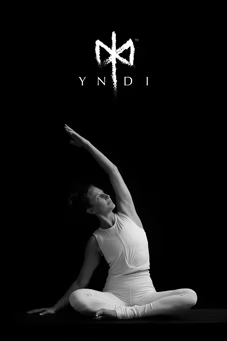

Support for PBS provided by:
Virginia Home Grown is a local public television program presented by VPM
